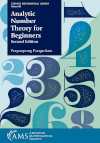- About MAA
- Membership
- MAA Publications
- Periodicals
- Blogs
- MAA Book Series
- MAA Press (an imprint of the AMS)
- MAA Notes
- MAA Reviews
- Mathematical Communication
- Information for Libraries
- Author Resources
- Advertise with MAA
- Meetings
- Competitions
- Programs
- Communities
- MAA Sections
- SIGMAA
- MAA Connect
- Students
- MAA Awards
- Awards Booklets
- Writing Awards
- Teaching Awards
- Service Awards
- Research Awards
- Lecture Awards
- Putnam Competition Individual and Team Winners
- D. E. Shaw Group AMC 8 Awards & Certificates
- Maryam Mirzakhani AMC 10 A Awards & Certificates
- Two Sigma AMC 10 B Awards & Certificates
- Jane Street AMC 12 A Awards & Certificates
- Akamai AMC 12 B Awards & Certificates
- High School Teachers
- News
You are here
Analytic Number Theory for Beginners

Buy Now:
Publisher:
AMS
Publication Date:
2023
Edition:
2
Series:
Student Mathematical Library
Price:
59.00
ISBN:
978-1-4704-6444-8
Category:
Textbook
[Reviewed by , on ]
John D. Cook
07/30/2023
Analytic Number Theory for Beginners by Prapanpong Pongsriiam covers a lot of material in under 400 pages. It is primarily a graduate textbook. It could be used as an undergraduate text: roughly speaking the first third of the book is undergraduate material and the remaining two thirds is graduate-level material, but the writing is a bit terse for an undergraduate text. Someone teaching an undergraduate course from the book could fill in details and also sprinkle in a few more advanced topics as time and interest allow.
The first chapter provides a brisk review of basic number theory, up to quadratic reciprocity. The second chapter introduces arithmetic functions and the Möbius inversion formula. The third chapter is devoted to the floor function. It is a little surprising that the book devotes more pages to the floor function than to basic number theory; the author says in the preface that most of this chapter is not necessary for the rest of the book.
The fourth chapter, covering summation formulas, transitions from undergraduate to graduate material concluding with the Euler-Maclaurin summation formula.
The fifth chapter returns to arithmetic functions, this time covering more advanced theory. Chapters six through nine cover the material one would expect in any course on analytic number theory: distribution of primes, Dirichlet's theorem, and the Riemann zeta function.
Chapter ten, the last chapter, added in the second edition, gives an introduction to sieve methods and additive number theory.
Each chapter has an extended section of notes following the exercises. These notes are more discursive, and in my opinion are the best part of the book. The body of each chapter is fast-paced and strictly business; the end notes are more informal. Rather than scatter informal commentary and digressions evenly through the book, these are concentrated in the notes. The former approach is more common, but the latter has its advantages. For one, I imagine it makes the book easier to use as a reference.
While this is a book for a first (graduate) course in analytic number theory, it contains recent results. For example, the book includes several theorems by Terrence Tao and his collaborators on primes in arithmetic progressions and on twin primes.
In sum, Analytic Number Theory for Beginners provides a brisk introduction to analytic number theory, with more than enough material for a graduate course.
John D. Cook is an independent consultant in applied mathematics and data privacy.
See the publisher's website.
- Log in to post comments




